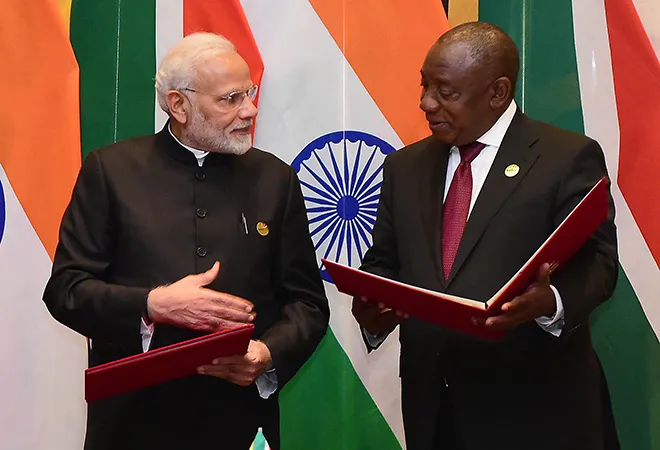
The ever-changing myriad geopolitical demands of the world have been continuously observing the perpetual renewal of newer cooperative constructs. The India-South Africa Three Year Strategic Programme of Cooperation (2019-2021) is one such instance of the cardinal ‘Look West’ or ‘Link West’ policy of India, moving beyond the generic notion of associating West Asia or the Middle East within the concept, refurbishing the importance of extended neighbourhood.
Signed in January this year, more than two months have passed since the President of South Africa, Matamela Cyril Ramaphosa, visited India at the invitation of Prime Minister Narendra Modi on the occasion of the 70th Republic Day Parade as the Chief Guest. Several issues ranging from defence and security to blue economy and Information Technology were brought under consideration, in order to enhance connectivity which has become one of the buzzwords of International Relations consequently promoting ingenious partnerships and identification of the mutual arenas of benefit. Zooming into the maritime and geo-strategic discourse, now the time seems to be ripe to actualise this coordinative effort, encompassing the Indo-Pacific, hence enhancing investment opportunities in South Africa and vice-versa.
Taking the thread from this perspective, India and South Africa have been working together right from the establishment of the Indian Ocean Rim Association (IORA) -- in maritime affairs -- in 1997 and BRICS (Brazil, Russia, India, China, South Africa) in 2010 -- as a gateway to the African continent -- just to state two of the most recent collaborations among others like the G-20 and the India-Brazil-South Africa (IBSA) Dialogue Forum. The concept of Indo-African synergy strengthened in popularity when late South African President Nelson Mandela, on a visit to India, spoke of it with much conviction and the growing socio-economic interconnectedness.
The presence of a very dynamic Indian diaspora in South Africa also deserves mention, which is capable of making the 21st century interactions much more fruitful and interesting. As pointed by Ruchira Kamboj, High Commissioner of India to South Africa, this “historical partnership is accelerating and igniting” with greater presence of Indians. Ergo it is time we move beyond the Gandhian link that has been inherent, to further deliberate new migratory flows. This is all the more relevant because of the often witnessed tussle between the new migrants and the Indians who have settled in South Africa since the 1800s. New space must be created for newer accommodations in people-to- people connectivity.
With time and the changing geopolitical and geo-economic narratives, the Indian Ocean has expanded. The portrayal now includes the wider connotation of the Indo-Pacific as well, stretching from the Eastern coast of Africa across the Indian Ocean to the Western Pacific to include countries like Japan and Australia, thereby providing better opportunities of building economy as well as becoming an apt illustration of Michel Foucault’s Power – Knowledge nexus that motivates an area as one of attention as well as contention for power. The implication here lies in the interests of the global or regional players to entrench themselves in a specific area as a ‘pivot’. In this regard, the Indo Pacific, with 44 per cent of the world surface area, contributing to 62 per cent of World GDP and 46 per cent of world merchandise trade is undoubtedly an area of such fascination that can help both India as well as South Africa in creating a growth corridor, backed by strategic undercurrents as well, possibly counterbalancing the overarching presence of China in the region. This region also remains underexplored in many of its facets which holds within itself great opportunities of burrowing into maritime resources and trade routes beyond the ones already in use.
Even though the Indian investments in this country figure below China or the United States of America, the positive vision is mainly due to the respect that India has always received for being a functioning democracy. As of now, from the economic perspective, India and South Africa have a total export growth percentage of 7.88 per cent and a total import growth percentage of around 17.16 per cent with the total trade growth percentage standing at 13.65 per cent, according to the 2017-18 data of the Department of Commerce, Government of India. On the grounds that India and South Africa do not have a very booming economic scenario, the identification of new measures becomes all the more relevant.
Likewise, if a new economic route comes to be established, connecting the Indo-Pacific, greater opportunities can come for both the countries, utilising important choke points like the Strait of Malacca and the Strait of Hormuz, with massive potential of maritime economy and usage of ocean resources through the participation in projects like the Africa Integrated Maritime Strategy (AIMS), to name one.
It is at this very juncture that the involvement of Japan in the entire scenario comes of prospective relevance, thereby creating an India-South Africa-Japan geostrategic arch, facilitating newer dimensions in regional integration and convenience. Taking cue from this idea, the Asia-Africa Growth Corridor (AAGC) may be forwarded, that has been more or less stagnant since its inception in the 52nd Annual Meeting of the African Development Bank in 2017, with a joint statement by Prime Minister Shinzo Abe of Japan and Narendra Modi, to work together. If this corridor is operationalized, then all the three countries will be able to harness the maximum benefit of the Indo-Pacific through regional trade, investment and building of connectivity infrastructures, presumably bypassing the giant Maritime Silk Route (MSR) of China, as an alternative.
Japan has always promoted a free and open Indo-Pacific. In the recent past, it has shown more interest to invest in Africa, after massive Chinese investments had come to the forefront. The Tokyo International Conference on African Development (TICAD) held every year, since 1993, is proof. Again, export from Japan to South Africa is around 281.6 billion yen and import from South Africa to Japan has been around 542.6 billion yen according to the 2017 data of the Ministry of Foreign Affairs, Japan. In this situation, the ‘global partnership’ of India and Japan can be rightly conjoined with the inclusion of South Africa. However, it requires proactive initiative and engagement as there is the lurking threat of massive China with the Forum on China-Africa Cooperation (FOCAC), which is also very lucrative for African countries, given the necessity to develop and prosper at par with the international partners. To be precise, the African continent, though splurged with choice at the moment, would need partnership for outreach and utilization of its resources. Nonetheless, it realises its importance as a ‘pivot’ as well. If India and Japan still want to strategise the arch, no time must be wasted.
Two important areas of such collaboration may be Blue Economy and the conduction of joint maritime exercises and drills in the Indo-Pacific, where the three countries can come together.
Japan can undoubtedly lead the axis. Japan and Africa are already working together in the realm of Blue economy, as more than one quarter of Africa’s population lives within 100 km of the coastline and derive their livelihood from there. Kenya has been actively involved in the Sustainable Blue Economy Conference (SBEC) in November, 2018. South Africa requires a similar thrust to move forward the Agenda 2063 of a developed African Union (AU), as well. How India can benefit from here is by associating the SAGAR (Security and Growth for All in the Region) as envisioned by Modi in 2015 with the AAGC. This is how Japan’s logistical assistance and expertise in areas like marine economy, aquaculture and development of ports can be procured in the best possible way.
As far as joint exercises are concerned, the IBSAMAR VI between India, Brazil and South African navies in 2018 and JIMEX -18 between India and Japan in 2018 are examples of collaborations that can easily be conducted between India, South Africa and Japan as a whole, separately in the Indo-Pacific. These can be garnered as very important push factors for furthering the effort.
Every international association must manifest into the development of the region with new perspectives at play. The idea is to reconnect and revive with constructive mechanisms, keeping in mind the threat of failure or stagnation, often witnessed in cases of regional cooperation. For example, the South Asian Association for Regional Cooperation (SAARC) or the Bangladesh Bhutan India Nepal (BBIN) connectivity network in South Asia could never generate consensus. It is only through critical evaluation and consideration of the intricate nuances that such a blue-print of connectivity and growth corridor beyond the immediate neighbourhood would be successful in practice.
The views expressed above belong to the author(s). ORF research and analyses now available on Telegram! Click here to access our curated content — blogs, longforms and interviews.




 PREV
PREV


